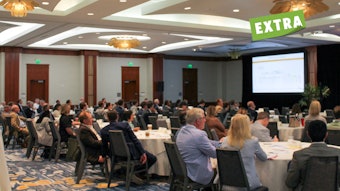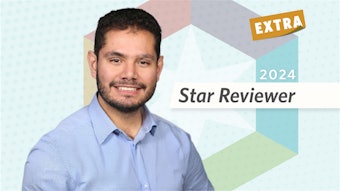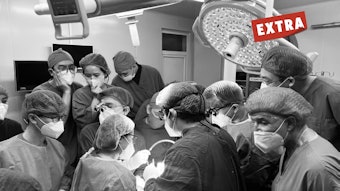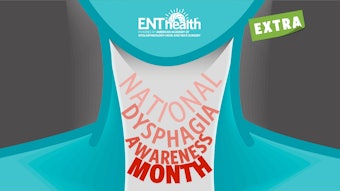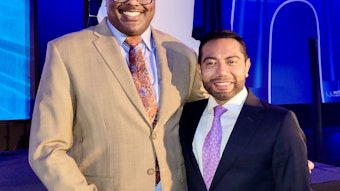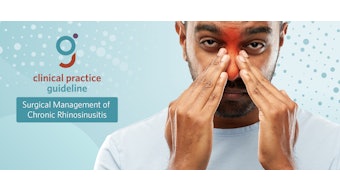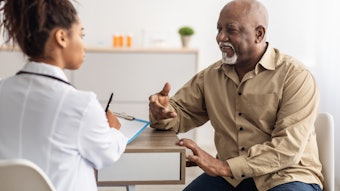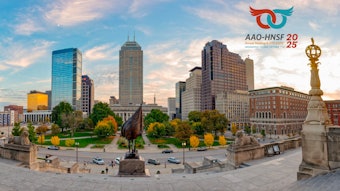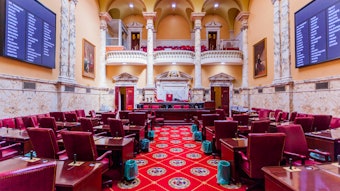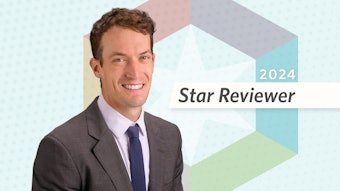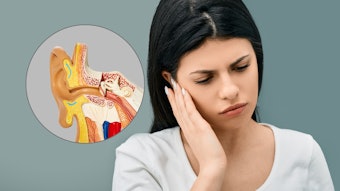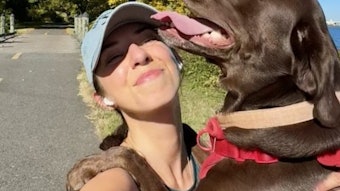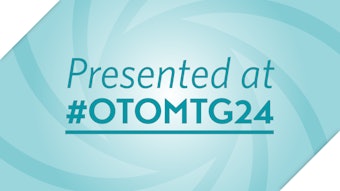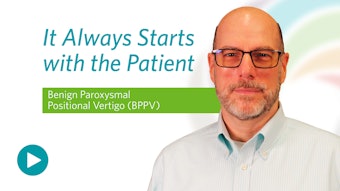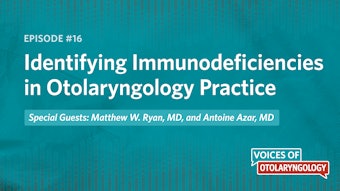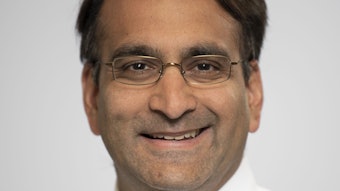Visiting the Dennis G. Pappas Historical Collections
Pioneering otolaryngologist-historian collected early otologic instruments, hearing aids, bloodletting devices, and more.
Megan A. Noonan, BS, and Glenn Isaacson, MD, on behalf of the History and Archives Committees
 Drs. Dennis G. Pappas Sr. (left) and Jr. at the UAB Historical Library.
Drs. Dennis G. Pappas Sr. (left) and Jr. at the UAB Historical Library.
The authors recently had an opportunity to visit the Dennis G. Pappas Historical Collections Gallery at the Lister Hill Library of Health Sciences at UAB.
A Pioneering Otologist
Dr. Pappas was born September 23, 1931, in Birmingham, Alabama, to a family in the fruit wholesaling business. He graduated from high school in 1948 and immediately started a job at the Hormel meat packing company. Having been persuaded to seek higher education, he studied architecture at the University of California, Berkeley. He returned to Alabama and completed his undergraduate education in 1954. Dr. Pappas was accepted at the University of Tennessee School of Medicine at Memphis, graduating in 1958. He chose post-graduate training in radiology at the Mayo Clinic. On arriving, he learned his internship would be in Fargo, North Dakota, rather than Rochester, Minnesota, as he had expected.
During his rotating internship, Dr. Pappas met an otolaryngologist recently assigned to Fargo who was unpacking one of the newly developed operating microscopes. He was impressed by the otolaryngologist and the potential of oto-microscopy. After three months together, Dr. Pappas was persuaded to switch to otolaryngology training. He found a residency spot in the demanding head and neck otolaryngology residency at New York University. After completing his training, Dr. Pappas enlisted in the U.S. Army and spent the rest of the Vietnam War at Landstuhl Hospital, an Army post in Landstuhl, Germany. Rather than reconstructing war injuries, most of Dr. Pappas’ surgeries were tonsillectomies and septoplasties on healthy young service members; dull work for an eager young otolaryngologist. An otologist from California named William F. House, MD, visited the Army base, teaching Dr. Pappas and the other otolaryngologists about acoustic neuromas and cochlear implantation. Dr. House was impressed by Dr. Pappas and offered him a fellowship in Los Angeles.
Dr. Pappas then spent a year after fellowship practicing general otolaryngology in Arlington, Virginia, before returning to Birmingham and eventually founding the Pappas Ear Clinic (now Alabama Ear Specialists).
 Text at the UAB Historical Library documenting the early development of sign language.
Text at the UAB Historical Library documenting the early development of sign language.
The Historian and Collector
Dr. Pappas credits his interest in medical history to his wife, Patti, who gave him a Parke-Davis History of Medicine poster set early in his career. This sparked both his inquisitive and acquisitive spirits. Early in their collecting days, Dr. Pappas and his wife spent weekends going to flea markets and antique shops hunting for medical instruments and curiosities. The collection developed themes: early otologic instruments, hearing aids, bloodletting devices, medical quackery, and more. At first, the collections filled cabinets and drawers in their home. Soon, the collections became too extensive and too fascinating to keep locked in the basement. Many of their books and collectables became part of the exhibits at Birmingham’s McWane Science Center, Alabama Museum of the Health Sciences, and the UAB historical library.
 Ear trumpets. "The Grand Opera Dome" (top) is a dome variation with a silhouette much like the corsets adorning fashionable ladies of the Victorian era. The stately elegance of the "beehive configuration" enhances its aesthetic appeal but not its acoustic performance.
Ear trumpets. "The Grand Opera Dome" (top) is a dome variation with a silhouette much like the corsets adorning fashionable ladies of the Victorian era. The stately elegance of the "beehive configuration" enhances its aesthetic appeal but not its acoustic performance.
Today, Dr. Pappas spends less time collecting and more time researching the history of the items he has acquired. “It does something to stimulate you to keep looking and researching and trying to learn,” he said. “I just hope that I can live long enough now to finish [investigating] a lot of the little things I want to know about some of these.”
Recordings of Dr. Pappas discussing some of his items can be found online in the UAB Digital Collections.
 Bruton's otoscope, first described in The Lancet in 1865, represents a pivotal advancement in the development of otologic instruments. The addition of artificial light came later, vastly improving the instrument’s functionality.
Bruton's otoscope, first described in The Lancet in 1865, represents a pivotal advancement in the development of otologic instruments. The addition of artificial light came later, vastly improving the instrument’s functionality.
 The evolution of the treatment of hearing loss. The display not only chronicles the historical progression of hearing aids but also emphasizes that each era’s solutions were built along the insights and challenges that preceded them.
The evolution of the treatment of hearing loss. The display not only chronicles the historical progression of hearing aids but also emphasizes that each era’s solutions were built along the insights and challenges that preceded them.
 A trepanning instrument set. The set comprises several interrelated components, each playing a distinct role in the process of cranial surgery. Also used for suppurative mastoiditis.
A trepanning instrument set. The set comprises several interrelated components, each playing a distinct role in the process of cranial surgery. Also used for suppurative mastoiditis.
 A mid-19th century tonsillotome exemplifies the refined surgical craftsmanship of its era.
A mid-19th century tonsillotome exemplifies the refined surgical craftsmanship of its era.
Additional Resources:
Pappas DG. Targeted caricatures. Laryngoscope. 2009 Oct;119(10):1932-6. doi: 10.1002/lary.20571. PMID: 19650131.
Pappas DG Sr, Pappas DG Jr, McGuinn M. Adam Politzer as an art collector. Vienna: Neues Wiener Abendblatt 1920 Nov 17; Kunst und Kunstmarkt sect: no. 316. Translation. Otolaryngol Head Neck Surg. 1999 Dec;121(6):772-5. doi: 10.1053/hn.1999.v121.a97361. PMID: 10580236.
Pappas DG. Friedrich von Bezold (1842-1908). Ear Nose Throat J. 1996 Dec;75(12):760-1. PMID: 8991221.
Pappas DG. Hermann Hugo Rudolf Schwartze (1837-1910). Reintroduction of paracentesis and mastoid surgery. Ear Nose Throat J. 1996 Nov;75(11):708-9. PMID: 8972993.
Pappas DG. Anton Friedrich von Tröltsch (1829-1890). The beginning of otology in Germany. Ear Nose Throat J. 1996 Oct;75(10):650-1. PMID: 8942084.
Pappas DG. Friedrich Siebenmann (1852-1928). Ear Nose Throat J. 1996 Jun;75(6):340-2. PMID: 8689962.
Pappas DG. Arthur Hartmann (1849-1931). Ear Nose Throat J. 1996 May;75(5):282. PMID: 8935526.
Pappas DG. Otology through the ages. Otolaryngol Head Neck Surg. 1996 Feb;114(2):173-96. doi: 10.1016/S0194-59989670162-6. PMID: 8637729.
Pappas DG. Bondy's modified radical mastoidectomy revisited. Ear Nose Throat J. 1994 Jan;73(1):15-8. PMID: 8162866.
Pappas DG. Heinrich Neumann: multifaceted otologic surgeon. Otolaryngol Head Neck Surg. 1993 Sep;109(3 Pt 1):381-4. doi: 10.1177/019459989310900301. PMID: 8414552.
Pappas DG. Barany's History of Vestibular Physiology. Translation and commentary. Ann Otol Rhinol Laryngol Suppl. 1984 Mar-Apr;110:1-16. doi: 10.1177/00034894840932s201. PMID: 6424539.
Pappas DG. Sir William Wilde: a historical review. Ear Nose Throat J. 1983 Jun;62(6):321-4. PMID: 6347657.
Pappas DG. Alexander Graham Bell: teacher of the deaf. Am J Otol. 1983 Jan;4(3):263-5. PMID: 6338731.
Pappas DG, Galanos AN. Prosper Méniere: beyond the controversial autopsy report. South Med J. 1982 Apr;75(4):470-2. PMID: 7041283.
Pappas DG. The origin of aural instruments. Am J Otol. 1979 Oct;1(2):121-4. PMID: 400069.
